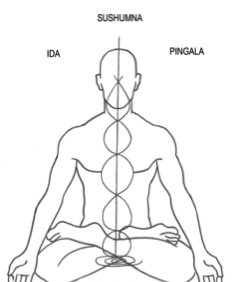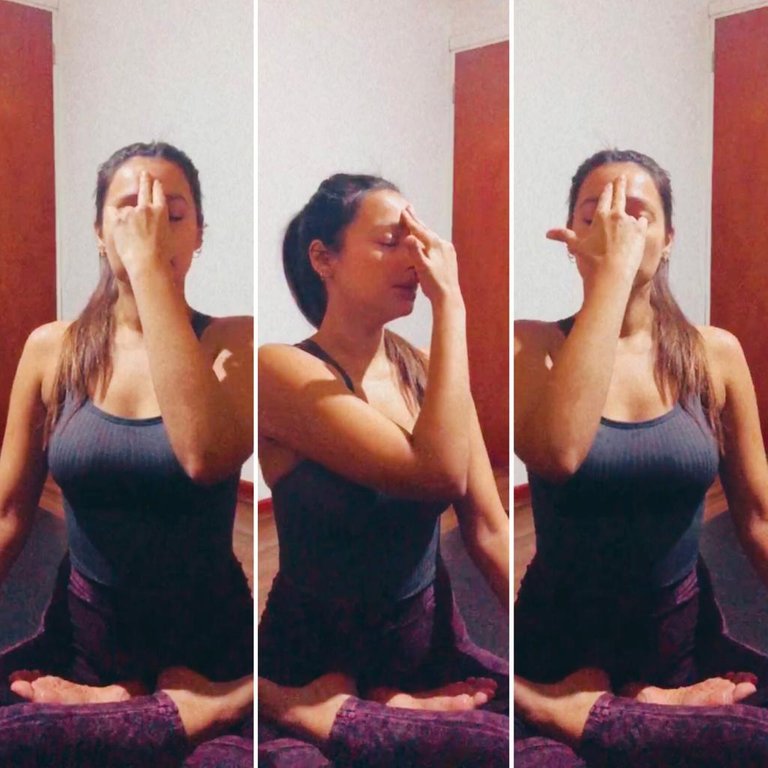.
Nadi Shodhan Pranayama
(purification of the psychic network)
It is also called universal pranayama, because it can be performed by all people and everyone should do it, among the benefits it provides, it purifies the energy channels and balances the energy of the body. All other pranayamas have some specific purpose or have restrictions. Nadi sodhana can be done 12 months of the year without restrictions.
.
The name comes from Sanskrit, and is composed of nadi, which means "channel" and sodhana, which means "purify, clean", they are psychic channels, where energy flows through different channels, we have 72 thousand psychic channels, all of them are called nadis, there are three nadis that are very important;
1- Nadi ida: it is our mental strength, it represents our mind, activities such as; thinking, contemplating, sleeping, all this is governed by nadi ida.
2- Nadi pingala: it is our vital force, activities like; speech, communication, walking, running, digestion, things like that. all vital activities are governed by nadi pingala.
3- Sushumna: it is our spiritual strength. When the two nadi ida and pingala are balanced, sushumna occurs, a state of mind in which you become calm, focused, and more mindful.

The purpose of nadi shodhan pranayama is to balance these two nadis, to balance the two hemispheres of the brain, the sympathetic nervous system and the parasympathetic nervous system and once the ida nadi and the pingala nadi have been balanced, the sushumna nadi awakens. Otherwise, only ida and pingala flow, sushumna remains inactive or flows in just a fraction of seconds, when the breath changes from the left nostril to the right, or from right to left, at that time the sushumna.
.
If we see some benefits of nadi sodhana; reduce impurities in any of its excesses, any toxin that appears in excess will be balanced by nadi sodhana, on a mental level, this practice facilitates the state of concentration, it is a mandatory practice for stress management since it eliminates it automatically, that it is the beauty of the nadi sodhana
.
How to do it?
- Sitting comfortably, in a meditative posture, or in any cross-legged posture, make sure your spine and head are straight.
- Place the left hand on the left knee, palms facing the sky or in Chin Mudra (the tips of the index finger and thumb touch).
- Place the tip of the index finger and the middle finger of the right hand between the eyebrows, the ring finger and the little finger in the left nostril and the thumb in the right nostril. We will use the ring finger and the little finger to open and close the left nostril and the thumb for the right nostril.
- With your thumb, cover the right nostril and breathe gently through the left nostril in 5 beats.
- Gently press the left nostril with the ring finger and little finger. Remove the thumb from the right nostril, exhale through the right in 5 beats.
- Inhale through the right nostril for 5 beats and exhale through the left, covering the right nostril again with your thumb. With this, one round of Nadi Shodhan pranayama is completed.
- Continue inhaling and exhaling alternate nostrils.
- Complete 6 rounds alternating breathing through both nostrils. After each exhalation, remember to inhale through the same nostril that you exhaled through.
- Keep your eyes closed, relax your whole body, and continue to breathe long and deep throughout the process without any effort.
Nadi Shodhan Pranayama
(purificación de la red psíquica)
También se le denomina pranayama universal, porque lo pueden realizar todas las personas y todo el mundo debería hacerlo, entre los beneficios que entrega, purifica los canales energéticos y equilibra la energía corporal. Todos los demás pranayamas tienen algún propósito específico o tienen restricciones. Nadi sodhana se puede realizar los 12 meses del año sin restricción.
El nombre proviene del sánscrito, y está compuesto por nadi, que significa “canal” y sodhana, que significa “purificar, limpiar”, son canales psíquicos, donde fluye la energía por diferentes canales, tenemos 72 mil canales psíquicos, todos ellos se llaman nadis, existen 3 nadis que son muy importantes;
1- Nadi ida: es nuestra fuerza mental, representa nuestra mente, las actividades como; pensar, contemplar, dormir, todas estas están gobernado por nadi ida.
2- Nadi pingala: es nuestra fuerza vital, actividades como; el habla, comunicacion, caminar, correr, la digestión, cosas asi. todas las actividades vitales están gobernadas por nadi pingala.
3- Sushumna: es nuestra fuerza espiritual. Cuando los dos nadi ida y pingala se han equilibrado ahí ocurre el sushumna, un estado de la mente cuando se calma, se enfoca, está más atenta.

El propósito de nadi shodhan pranayama, es equilibrar estos dos nadis, para equilibrar los dos hemisferio del cerebro, el sistema nervioso simpático y el sistema nervioso parasimpático y una vez el nadi ida y el nadi pingala se han equilibrado, entonces el nadi sushumna despierta, de lo contrario, solo fluye ida y pingala, sushumna permanece durmiente, o fluye en solo una fracción de segundos, cuando la respiración está cambiando de la fosa nasal izquierda a la derecha, o de la derecha a la izquierda, en ese momento fluye el sushumna.
Si vemos algunos beneficios de nadi sodhana; reducen las impurezas en cualquiera de sus excesos, cualquier toxina que aparezca en exceso se equilibraran mediante el nadi sodhana, a nivel mental, esta práctica facilita los estado de concentración, es una práctica obligatoria para la gestión del estrés ya que lo elimina automáticamente, esa es la belleza del nadi sodhana.
¿Cómo realizarlo?
- Sentarse cómodamente, postura meditativa o cualquier postura con las piernas cruzadas, asegúrate de tener la columna vertebral y la cabeza recta.
- Coloca la mano izquierda sobre la rodilla izquierda, palmas mirando hacia al cielo o en Chin Mudra (se tocan la punta del dedo índice y pulgar).
- Coloca la punta del dedo índice y el dedo medio de la mano derecha en el entrecejo, el dedo anular y meñique en la fosa nasal izquierda y el pulgar en la fosa nasal derecha . Utilizaremos el anular y el meñique para abrir y cerrar la fosa izquierda y el pulgar para la fosa derecha.
- Con tu pulgar tapa la fosa nasal derecha y gentilmente respira por la fosa nasal izquierda en 5 tiempos.
- Suavemente presiona la fosa nasal izquierda con el dedo anular y meñique. Quita el dedo pulgar de la fosa derecha, exhala por la derecha en 5 tiempos.
- Inhala por la fosa derecha en 5 tiempos y exhala por la izquierda, tapando la fosa nasal derecha nuevamente con el pulgar. Con esto, se completa un ronda de Nadi Shodhan pranayama.
- Continúa inhalando y exhalando alternando las fosas nasales.
- Completa 6 rondas alternando la respiración por ambas fosas. Después de cada exhalación, recuerda inhalar por la misma fosa por la cual exhalaste.
- Mantén tus ojos cerrados, relajando todo el cuerpo y continúa tomando respiraciones largas y profundas durante todo el proceso sin ningún esfuerzo.

Performing this pranayama a few minutes a day is the best to de-stress the mind, release tension and accumulated fatigue.
namasté.❤️
Realizar algunos minutos del día este pranayama, es lo mejor para desestresar la mente, liberar la tensión, y el cansancio acumulado.
namasté. ❤️
Awesome info that is the core secret of the yoga and meditation practice. Many thanks.
Thanks for reading, the magic of breathing that brings us back to the present moment ❤️
Hi. Thank you for this. Bytheway. You are so beautiful
Thank you for sharing
Thank you 😊
Congratulations @katherinevc! You have completed the following achievement on the Hive blockchain and have been rewarded with new badge(s) :
Your next target is to reach 1500 upvotes.
You can view your badges on your board and compare yourself to others in the Ranking
If you no longer want to receive notifications, reply to this comment with the word
STOPCheck out the last post from @hivebuzz:
Support the HiveBuzz project. Vote for our proposal!
Muy buen aporte, me encantó, está muy bien explicado. Es muy buen preambulo meditativo.
Abrazo.
@karmadorje
Earn Instantly For Writing Natural Health Content
Earn LOTUS and HIVE rewards for sharing your natural health content on www.naturalmedicine.io. If you don't already have a HIVE account, you can sign up for
FREEhere. We support writers sharing about herbalism, TCM, yoga, meditation, vegan and other healthy diets, as well as earth centred practices such as foraging, permaculture and biodynamics - read more about us on our Welcome Page!Excelente Katherine.